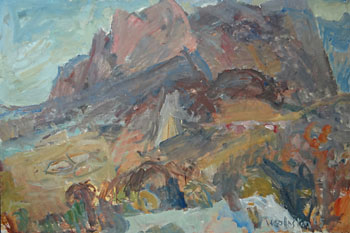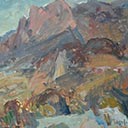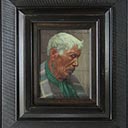The Hohonu
81.1 x 121.5 cm
PROVENANCE
Private Collection, Nelson
Sutor Gallery, Nelson, Loan Collection, label verso
Woollaston's path to the vigorously compressed space of The Hohonu is a journey of artistic discovery that begins with his first "excited" childhood glimpse of Paul Cézanne's post-impressionism. Recalling the importance of this moment in 1988 Toss Woollaston (1910-1998) said "for some reason I couldn't stop looking at that painting" even though "I didn't know the name of Cézanne; and the book said 'these painters were very doubtful indeed.'"
Hohonu is a range of mountains in Westland, rising abruptly behind the broad boulder-strewn Taramakau River next to the Otira Highway. It is less than an hour's drive from Greymouth - which is where Woollaston had moved with his family in 1950 to take up his Rawleigh's sales job in the hope that this would provide more secure income for his family that the seasonal orchard work in Nelson had done. Though the move was misjudged from a financial perspective, Greymouth provided artistic camaraderie at least as he joined the local sketching and painting group for regular excursions. This period was also when Woollaston had the courage to start painting larger works, on the encouragement of Christchurch's first contemporary art dealer, Hungarian Andre Brooke. The Hohonu comes late in his Greymouth time, just a few years before he and the family returned to the Motueka area, buoyed by the new and highly supportive relationship with then-emerging gallerist Peter McLeavey.
Woollaston's artistic achievement is heroic when seen in light of his almost total isolation from the European influences which set a course towards his own brand of modernism. The first painting that truly excited him - the small, black and white Paul Cézanne self-portrait reproduced in Arthur Mee's The Children's Encyclopaedia - was followed by his studies of Cézanne in "love and awe" in R. N. Field's Dunedin studio where the young artist was permitted to "paint what you wanted to;" and then by his encounter with Munich-trained Flora Scales. Only a few sessions with Scales confirmed Woollaston's distrust of vanishing point perspective; and reinforced the importance of "the flatness of the canvas, where objects lay against each other in a series of overlapping planes" and where "colours were no longer to imitate reality but to create harmonies." Nowadays, the idea that an artist could find his own way towards the avant-garde discoveries of modernism with so few and only second-hand exposures to key influences is extremely hard to imagine. Yet, in these few contacts Woollaston absorbed and surpassed the lessons of Cézanne. By the mid-1960s and The Hohonu he was piling one leaning plan upon another; stacking the forms of the mountains - which rise above the up-tilted plane of the Taramakau River - so high that the summits press against the upper frame of the painting in a series of vigorous brush strokes that collapse distance and create painterly mass, presence and immediacy. Rob Garrett





